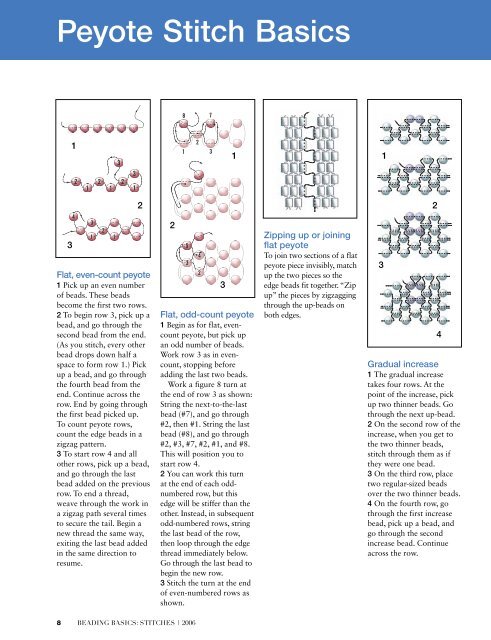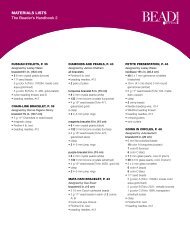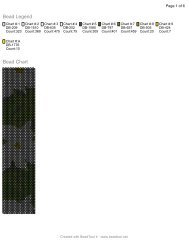Peyote Stitch Basics - Bead and Button Magazine
Peyote Stitch Basics - Bead and Button Magazine
Peyote Stitch Basics - Bead and Button Magazine
You also want an ePaper? Increase the reach of your titles
YUMPU automatically turns print PDFs into web optimized ePapers that Google loves.
<strong>Peyote</strong> <strong>Stitch</strong> <strong>Basics</strong>8 7132 1 2 1 213123113431212Flat, even-count peyote1 Pick up an even numberof beads. These beadsbecome the first two rows.2 To begin row 3, pick up abead, <strong>and</strong> go through thesecond bead from the end.(As you stitch, every otherbead drops down half aspace to form row 1.) Pickup a bead, <strong>and</strong> go throughthe fourth bead from theend. Continue across therow. End by going throughthe first bead picked up.To count peyote rows,count the edge beads in azigzag pattern.3 To start row 4 <strong>and</strong> allother rows, pick up a bead,<strong>and</strong> go through the lastbead added on the previousrow. To end a thread,weave through the work ina zigzag path several timesto secure the tail. Begin anew thread the same way,exiting the last bead addedin the same direction toresume.253423Flat, odd-count peyote1 Begin as for flat, evencountpeyote, but pick upan odd number of beads.Work row 3 as in evencount,stopping beforeadding the last two beads.Work a figure 8 turn atthe end of row 3 as shown:String the next-to-the-lastbead (#7), <strong>and</strong> go through#2, then #1. String the lastbead (#8), <strong>and</strong> go through#2, #3, #7, #2, #1, <strong>and</strong> #8.This will position you tostart row 4.2 You can work this turnat the end of each oddnumberedrow, but thisedge will be stiffer than theother. Instead, in subsequentodd-numbered rows, stringthe last bead of the row,then loop through the edgethread immediately below.Go through the last bead tobegin the new row.3 <strong>Stitch</strong> the turn at the endof even-numbered rows asshown.Zipping up or joiningflat peyoteTo join two sections of a flatpeyote piece invisibly, matchup the two pieces so theedge beads fit together. “Zipup” the pieces by zigzaggingthrough the up-beads onboth edges.324Gradual increase1 The gradual increasetakes four rows. At thepoint of the increase, pickup two thinner beads. Gothrough the next up-bead.2 On the second row of theincrease, when you get tothe two thinner beads,stitch through them as ifthey were one bead.3 On the third row, placetwo regular-sized beadsover the two thinner beads.4 On the fourth row, gothrough the first increasebead, pick up a bead, <strong>and</strong>go through the secondincrease bead. Continueacross the row.8 BEADING BASICS: STITCHES | 2006
11121243Gradual decrease1 The gradual decreasetakes four rows. At thepoint of the decrease, gothrough two up-beads.2 On the second row of thedecrease, put two thinnerbeads in the open space,<strong>and</strong> go through the nextup-bead.3 On the third row, gothrough the two thinnerbeads as if they wereone bead.4 On the fourth row,pick up one bead, <strong>and</strong> gothrough the next up-bead.Rapid increase1 At the point of theincrease, pick up two beadsinstead of one. Go throughthe next bead.2 When you reach the twobeads on the next row, gothrough the first bead, adda bead, <strong>and</strong> go through thesecond bead.122Rapid decrease1 At the point of thedecrease, go through twobeads on the previous row.2 On the next row, whenyou reach the two-beadspace, pick up one bead.Two-drop peyoteWork two-drop peyotestitch the same as basicpeyote, but treat pairs ofbeads as if they weresingle beads.1 Start with an evennumber of beads divisibleby four.2 Pick up two beads (stitch1 of row 3), skip two beads,<strong>and</strong> go through the nexttwo beads. Repeat acrossthe row.3Round 2knot2Round 4Round 3Round 1Tubular or circulareven-count peyote1 Pick up an even numberof beads to equal thedesired circumference.Knot the thread to form aring, leaving some slack.2 Put the ring over a form ifdesired. Go through the firstbead to the left of the knot.Pick up a bead, skip a beadon the previous round, <strong>and</strong>go through the next bead.Repeat around until you’reback at the start.3 Since you started with aneven number of beads, youneed to step up to be inposition to start the nextround. Go through the firstbeads on rounds 2 <strong>and</strong> 3.Pick up a bead, <strong>and</strong> gothrough the second beadon round 3; continue.4 If you begin with an oddnumber of beads, you won’tneed to step up. The beadsform a continuous spiral.BEADANDBUTTON.COM 9
















